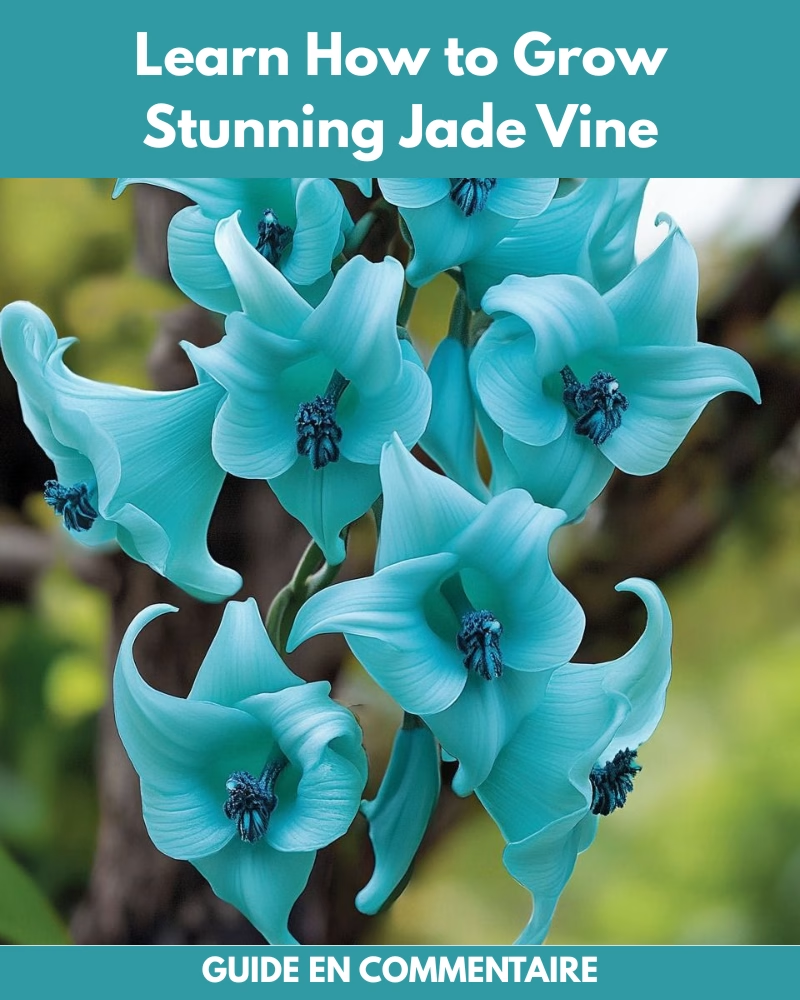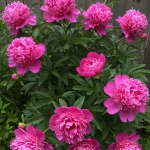Choosing the Right Location
Selecting the perfect location is critical for Jade Vine success. This large, vigorous climber needs substantial space and strong support structures to accommodate its mature size.
Location considerations:
- Space requirements: Plan for 20-30 feet of climbing space
- Support structures: Strong pergolas, arbors, or greenhouse frameworks
- Air circulation: Good airflow to prevent fungal issues
- Protection: Shelter from strong winds and temperature extremes
- Accessibility: Easy access for maintenance and viewing
Soil Preparation and Requirements
Jade Vine thrives in rich, well-draining soil that retains moisture without becoming waterlogged. The soil should be slightly acidic to neutral with excellent organic content.
Ideal soil composition:
- pH level: 6.0-7.0 (slightly acidic to neutral)
- Drainage: Well-draining but moisture-retentive
- Organic matter: High content of compost and organic materials
- Texture: Loose, friable soil that roots can easily penetrate
- Depth: At least 18 inches of prepared soil
Soil preparation steps:
- Test existing soil pH and drainage
- Excavate planting area to 18 inches deep
- Mix in 50% high-quality compost or aged manure
- Add perlite or coarse sand to improve drainage
- Incorporate slow-release organic fertilizer
- Allow soil to settle for several weeks before planting
Planting Jade Vine
Jade Vine is typically propagated from cuttings or seeds, with cuttings being the more reliable method for home gardeners.
Planting process:
- Timing: Plant during warm weather when temperatures are consistently above 70°F
- Hole preparation: Dig a hole twice as wide as the root ball and the same depth
- Root handling: Gently tease apart any circling roots
- Placement: Position the plant at the same depth it was growing previously
- Backfilling: Use prepared soil mixture and water thoroughly
- Support: Install temporary support stakes immediately
- Mulching: Apply 2-3 inches of organic mulch around the base
Essential Jade Vine Care Practices
Watering Requirements
Consistent moisture is crucial for Jade Vine, but the plant is sensitive to both drought and waterlogging. The goal is to maintain evenly moist soil that never completely dries out or becomes soggy.
Watering guidelines:
- Check soil moisture daily during growing season
- Water when top inch of soil feels slightly dry
- Provide deep, thorough watering rather than frequent shallow watering
- Use room temperature water to avoid shocking the roots
- Reduce watering slightly during cooler months
- Ensure excellent drainage to prevent root rot
Signs of watering problems:
- Overwatering: Yellow leaves, musty soil odor, root rot
- Underwatering: Wilting, brown leaf edges, flower bud drop
Fertilizing for Optimal Growth and Flowering
Jade Vine is a vigorous grower that requires regular feeding to support its large size and spectacular flowering displays. A balanced approach with both slow-release and liquid fertilizers works best.
Fertilization program:
- Spring: Apply slow-release balanced fertilizer (10-10-10 or 12-12-12)
- Growing season: Monthly liquid fertilizer applications
- Flowering period: High-phosphorus fertilizer to promote blooms
- Organic options: Compost, worm castings, and fish emulsion
- Micronutrients: Regular applications of chelated iron and trace elements
Fertilizer schedule by season:
- Spring: Heavy feeding to support new growth
- Summer: Regular balanced feeding with phosphorus boost
- Fall: Reduced nitrogen, increased potassium for winter hardiness
- Winter: Minimal feeding in dormant or slow-growth periods
Pruning and Training
Proper pruning and training are essential for managing Jade Vine’s vigorous growth and encouraging maximum flowering. This fast-growing vine can quickly become unmanageable without regular attention.
Pruning principles:
- Timing: Prune after flowering to avoid removing flower buds
- Young plants: Focus on training and establishing strong framework
- Mature plants: Remove dead, damaged, or overcrowded growth
- Flower clusters: Allow spent flowers to remain for seed pod development
- Vigorous growth: Regular thinning to maintain plant health
Training techniques:
- Install permanent support structures before planting
- Guide young shoots to desired framework
- Tie stems loosely with soft materials
- Encourage horizontal growth for better flowering
- Remove shoots growing in unwanted directions
Support Structures for Jade Vine
Designing Adequate Support
Jade Vine’s substantial size and weight require robust support structures that can withstand the plant’s mature dimensions. Planning for long-term support is essential.
Support structure options:
- Pergolas: Sturdy wooden or metal frameworks
- Arbors: Decorative structures for smaller spaces
- Greenhouse frameworks: Specialized supports for protected cultivation
- Fence systems: Strong fencing with horizontal supports
- Tree supports: Using existing large trees as natural supports
Construction considerations:
- Use materials rated for substantial weight loads
- Ensure proper anchoring and foundation support
- Plan for 20-30 feet of climbing space
- Include horizontal supports for optimal flowering
- Consider maintenance access in design
Greenhouse Cultivation
Growing Jade Vine in a greenhouse provides the controlled environment necessary for success in temperate climates. Proper greenhouse setup is crucial for long-term plant health.
Greenhouse requirements:
- Size: Minimum 12 feet high with adequate length for growth
- Temperature control: Heating and cooling systems for year-round consistency
- Humidity management: Automatic misting and ventilation systems
- Support systems: Overhead frameworks for vine training
- Lighting: Supplemental lighting if natural light is insufficient
Jade Vine Flowering and Reproduction
Understanding the Flowering Cycle
Jade Vine flowering is a spectacular event that typically occurs during the plant’s mature years. Young plants may take 3-5 years to produce their first flowers, but the wait is worth it.
Flowering characteristics:
- Season: Typically flowers in spring and early summer
- Duration: Individual flowers last 1-2 weeks
- Clusters: Racemes can contain 75-100 individual flowers
- Size: Flower clusters reach 2-3 feet in length
- Color: Unique turquoise-blue that intensifies with age
Factors affecting flowering:
- Plant maturity: Minimum 3-5 years for first blooms
- Temperature consistency: Stable warm temperatures crucial
- Light levels: Adequate but not excessive light
- Root restriction: Slightly pot-bound plants often flower better
- Stress factors: Minimal stress promotes flowering
Pollination and Seed Production
In its native habitat, Jade Vine is pollinated by fruit bats, but in cultivation, hand pollination may be necessary for seed production.
Hand pollination process:
- Identify receptive flowers (stigma appears moist and sticky)
- Collect pollen from mature anthers using small brush
- Transfer pollen to stigma of receptive flowers
- Mark pollinated flowers for tracking
- Allow seed pods to develop and mature naturally
Common Jade Vine Problems and Solutions
Environmental Stress Issues
Jade Vine is sensitive to environmental changes and can exhibit stress symptoms when conditions aren’t optimal.
Temperature stress:
- Symptoms: Leaf yellowing, growth slowdown, flower bud drop
- Solutions: Maintain consistent temperatures, provide protection from extremes
- Prevention: Use greenhouse cultivation in variable climates
Humidity problems:
- Symptoms: Brown leaf edges, poor growth, no flowering
- Solutions: Increase humidity through misting, humidifiers, or grouping plants
- Prevention: Monitor humidity levels and maintain 70-90% range
Pest Management
While Jade Vine has few serious pest problems, several insects can occasionally cause issues.
Common pests:
- Scale insects: Small, hard bumps on stems and leaves
- Mealybugs: White, cottony insects in leaf joints
- Spider mites: Tiny pests causing stippled, yellowing leaves
- Aphids: Soft-bodied insects clustering on new growth
Pest control methods:
- Physical removal: Hand-picking or washing off with water
- Insecticidal soap: Safe, effective treatment for soft-bodied insects
- Neem oil: Natural pesticide for various pest problems
- Beneficial insects: Introduce predatory insects for biological control
Disease Prevention
Preventing diseases is much easier than treating them, especially with a sensitive plant like Jade Vine.
Common disease issues:
- Root rot: Caused by overwatering or poor drainage
- Fungal leaf spots: Result of high humidity with poor air circulation
- Bacterial infections: Often enter through wounds or damaged tissue
Disease prevention strategies:
- Ensure excellent drainage and avoid overwatering
- Provide good air circulation around plants
- Avoid wetting foliage when watering
- Remove damaged or dead plant material promptly
- Quarantine new plants before introducing to collection
Propagating Jade Vine
Propagation from Cuttings
Growing Jade Vine from cuttings is the most reliable propagation method for home gardeners, though it requires patience and optimal conditions.
Cutting propagation steps:
- Timing: Take cuttings during active growing season
- Selection: Choose healthy, semi-hardwood stems 6-8 inches long
- Preparation: Remove lower leaves, make clean cuts below nodes
- Rooting hormone: Apply rooting hormone to cut ends
- Medium: Plant in well-draining propagation mix
- Environment: Maintain high humidity and warm temperatures
- Patience: Rooting can take 2-4 months
Rooting environment requirements:
- Temperature: 75-80°F consistently
- Humidity: 80-90% with misting system
- Light: Bright, indirect light only
- Air circulation: Gentle airflow to prevent fungal issues
Growing from Seeds
Seed propagation is possible but challenging, requiring fresh seeds and optimal conditions for germination.
Seed starting process:
- Fresh seeds: Use seeds collected from mature pods
- Scarification: Gently file or nick hard seed coat
- Soaking: Soak seeds in warm water for 24 hours
- Planting: Plant in warm, humid propagation environment
- Germination: May take several weeks to months
- Patience: Seedlings grow slowly and need constant care
Jade Vine Varieties and Related Species
Strongylodon macrobotrys Cultivars
While the classic turquoise-blue Jade Vine is the most common, there are subtle variations in flower color and plant characteristics.
Notable characteristics:
- Classic form: Deep turquoise-blue flowers
- Color variations: Some plants show more blue or green tones
- Size differences: Flower cluster size can vary between plants
- Growth habits: Some specimens are more vigorous than others
Related Strongylodon Species
Several other Strongylodon species exist, though they are even rarer in cultivation than the classic Jade Vine.
Other species:
- Strongylodon lucidus: Red-flowered relative from Philippines
- Strongylodon ruber: Another red-flowered species
- Regional variations: Various local forms with subtle differences
Jade Vine in Landscape Design
Creating Stunning Displays
Jade Vine’s spectacular flowers make it a natural focal point in any garden design. Planning for its impressive mature size is essential.
Design applications:
- Specimen plant: Single plant as garden centerpiece
- Pergola covering: Dramatic overhead canopy of flowers
- Greenhouse feature: Central attraction in tropical collections
- Entrance statement: Welcoming display at garden entrances
- Photographic subject: Perfect for garden photography
Companion Planting
Choosing appropriate companion plants enhances Jade Vine’s tropical appeal while providing complementary growing conditions.
Excellent companions:
- Tropical foliage plants: Monstera, Philodendron, Alocasia
- Orchids: Epiphytic orchids for added floral interest
- Bromeliads: Colorful tropical plants with similar humidity needs
- Ferns: Lush green backdrop for spectacular flowers
- Other tropical vines: Non-competing climbers for layered interest
Conservation and Rarity
Conservation Status
Jade Vine is considered rare and endangered in its native habitat due to deforestation and habitat destruction. Growing this plant in cultivation helps preserve genetic diversity.
Conservation importance:
- Habitat loss threatens wild populations
- Cultivation helps maintain genetic diversity
- Seed sharing preserves plant for future generations
- Educational value raises awareness of tropical plant conservation
Sustainable Growing Practices
Growing Jade Vine responsibly includes supporting conservation efforts and sustainable practices.
Sustainable approaches:
- Purchase plants from reputable, ethical sources
- Participate in seed exchange programs
- Support conservation organizations
- Share knowledge and propagation material with other growers
- Avoid collecting plants from wild populations
Seasonal Care Calendar
Spring Care (March-May)
- Resume regular fertilization program
- Increase watering as growth accelerates
- Begin training new shoots to support structures
- Watch for pest activity as temperatures warm
- Apply fresh mulch around root zone
Summer Care (June-August)
- Maintain consistent watering and humidity
- Continue monthly fertilization schedule
- Monitor for flowering and provide support for heavy clusters
- Increase ventilation in greenhouse settings
- Watch for heat stress during extreme temperatures
Fall Care (September-November)
- Reduce fertilization frequency
- Begin preparing for cooler weather
- Collect seeds from mature pods if desired
- Plan any necessary pruning for winter
- Gradually reduce watering as growth slows
Winter Care (December-February)
- Maintain minimum temperatures above 60°F
- Reduce watering but don’t allow complete drying
- Provide supplemental humidity in heated spaces
- Plan for next year’s support structure improvements
- Order propagation supplies for spring activities
Advanced Growing Techniques
Hydroponic Cultivation
Jade Vine can be grown hydroponically with proper attention to nutrient balance and root support.
Hydroponic considerations:
- Use nutrient solutions designed for flowering plants
- Maintain proper pH levels (6.0-6.5)
- Provide adequate root support and aeration
- Monitor nutrient concentrations carefully
- Maintain optimal temperature and humidity
Bonsai Training
While unusual, Jade Vine can be trained as a large bonsai specimen with careful pruning and root restriction.
Bonsai techniques:
- Regular root pruning to maintain size
- Careful branch selection and training
- Appropriate container sizing
- Modified fertilization program
- Patient approach to development
Troubleshooting Common Issues
No Flowering Problems
When Jade Vine fails to flower, several factors could be responsible.
Potential causes and solutions:
- Plant too young: Wait for maturity (3-5 years minimum)
- Insufficient light: Increase light levels gradually
- Too much nitrogen: Reduce nitrogen fertilization
- Temperature fluctuations: Maintain consistent warm temperatures
- Root disturbance: Avoid unnecessary repotting
Growth and Health Issues
Addressing common growth problems quickly prevents more serious issues.
Symptom diagnosis:
- Yellowing leaves: Often indicates watering or nutrient problems
- Brown leaf tips: Usually humidity or fertilizer burn issues
- Stunted growth: May indicate root problems or environmental stress
- Leaf drop: Often caused by environmental changes or stress
Conclusion: Success with Spectacular Jade Vine
Growing the magnificent Jade Vine successfully requires dedication, patience, and attention to its specific needs, but the rewards are extraordinary. Few plants can match the breathtaking beauty of those cascading turquoise flower clusters that seem to glow with an otherworldly light.
Success with Jade Vine comes from understanding and replicating its natural rainforest environment: consistent warmth, high humidity, filtered light, and rich, well-draining soil. Whether you’re growing this tropical treasure in a greenhouse or in a warm climate garden, maintaining these conditions is key to healthy growth and spectacular flowering.
Remember that Jade Vine is a long-term commitment that may take several years to reach flowering maturity. This patience is rewarded with one of nature’s most spectacular floral displays. The plant’s rarity and conservation status make successful cultivation even more meaningful, as every thriving Jade Vine helps preserve this extraordinary species for future generations.
Start with the best possible growing conditions, be patient with the plant’s development, and maintain consistent care practices. With proper attention to its needs, your Jade Vine will eventually reward you with those legendary turquoise flowers that make this plant one of the most coveted specimens in the tropical plant world.
Your journey with Jade Vine represents more than just growing a beautiful plant – it’s participating in the conservation of one of nature’s most remarkable flowering treasures. The spectacular blooms that await make every effort worthwhile, creating a living masterpiece that few gardeners ever have the privilege to witness firsthand.


